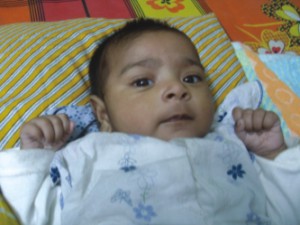Last & Least
The first few sounds in human life

A child appears in the open air of the world through a cry. That cry means a lot. It is the beginning of breath. It is the beginning of life on earth. Amid sobs, the cry makes mother and others laugh. It ends the 9/10 month long gestation period, the critical time for the baby as well as the mother. During this period a zygote turns into a foetus and the foetus turns into a baby. The baby by the time has developed all the limbs of a human being and is capable of surviving in the open air, of course with the protection and care of adults.
To me, the most fantastic development in a baby's body is that of vocal tract. It includes mouth with lips, tongue, palate and jaw, nose, and windpipe with larynx and pharynx. The full apparatus is ready to pronounce any word, but cannot produce any. First, neuronal function is yet to be triggered by practical experience of sound input. Secondly, the vocal organs are yet to be trained for movement and shape in particular way. And thirdly, no coordination has yet been established between the brain and the vocal organs. The use of language is a complicated process. The child has to wait at least six months for uttering any word and six years to acquire a language system.
In the first few months a child is able to produce only such scraps of sounds as 'a', 'o', 'm' and 'w' (phoneticians term such individual discrete sound as phoneme). The first two phonemes are vowels, the third one is consonant and the fourth one is semi-vowel. The last two are pronounced in conjunction with the available vowels, giving rise to such combinations as -- 'ma', 'wa', 'oma' and 'ama'. This must be observed universally. In normal case, the first vocalisation of a human child is bound to take place in the same way, as all children are supposed to have the same physiological features as members of a single species.
But can we call them sounds of language at all? The sound 'a' is pronounced with open mouth while the vocal cords vibrate; 'o' is also pronounced in the same way but with lip rounding. For 'm', the lips are shut so the air from lungs passes through the nose, and for 'w', the pair of lips makes a narrow-open stricture while air passes through the oral cavity. For 'ma', 'wa', 'oma' and 'ama', the position of vocal cords are accompanied by particular shapes of lips and other parts of mouth, however, ending in open posture in all cases.
The vocalisations that a neonate makes are not any sounds of language at all. They are merely noise. They are crying sounds; as, in fact, they are produced when a child cries. They are devoid of any linguistic value per se though they might have some communicative value. The child informs the world that it is hungry or in some other discomfort. The message is propagated with cry. And it is done instinctively.
All the vowels and consonants coming out as the manifestations of cry will however be of use in immediate future of baby's life. When the baby will start learning a language, they will be utilised in words. The cry sounds will be part of phonemic system of the language, in which the baby is born. All languages of the world should have the above sounds. If any language happens to lack any of them, the child will cease to use it. It will be eliminated from the child's repertoire of phonemes with 'parametric switching-off', to use a term of Noam Chomsky.
The most interesting of all the cry sounds is probably 'ma'. Technically, the stream of sounds (phonemes) is composed of a consonant described as 'bilabial nasal' and a vowel described as 'open central'. The adult ears are easily caught by the sound stream though spurting out as cry. It seems to be most articulate and distinct of all the initial vocalisations. It has no meaning, primarily, as it is not a word. But the adults will soon give it a status of word, ascribing meaning to it. In many societies of the world, the word is attached to the person who has given birth to the child -- mother. The role of a mother is thus recognised first, linguistically. In Bangla also, 'ma' simply means 'mother'.
We can examine some other languages to see how the stream of sounds in questions ('ma') is associated with the meaning of mother. I have conducted a little research in this regard. I found that most of the languages use the consonant sound ('m') in association with other sound(s) to refer to mother. This is significant. The adults think that the child calls mother with the sounds centring on the bilabial nasal. It makes a point for the onomatopoeic origin of language, which claims that the words of human languages originated from the sounds available in nature -- humans just picked them up for their tongue.
Apart from Bangla, the languages that use 'ma' to mean mother include: Mandarin Chinese, Afrikaans, Asturian, Hindi, Portuguese and Brazilian, though some of them have alternative words for this. For example, Afrikaans also uses 'moeder' and Hindi 'maji' side by side with 'ma'.
Some languages use vowels, monophthong or diphthong, other than 'a' after 'm'. For example: Aragones 'mai', Leonese 'mai', Punjabi 'mai' (alternative 'mataji'/'pabbo'), Thai 'mae', Zeneize 'moæ' and Vietnamese 'm?'. Noticeably, of these, the first three languages use a common diphthong 'ai'.
Some languages reduplicates the syllable 'ma', making mother 'mama', such as English, Swahili, Lingala, Hungarian, Lithuanian, Polish, Quechua, Romanian, Sardinian, Slovak and Spanish. But all of them have other alternatives, however. For example, English 'mother'/'mom', Polish 'matka', Slovak 'matka', Spanish 'madre'/'mami', Hungarian 'anya'/'fu', Romanian 'maica' and Swahili 'mzazi'/'mzaa'. The reduplication with an additional ending phoneme is found in Persian 'maman' (alternative 'madr'). Reduplication is also made with a changed vowel; from example: Albanian 'mëmë' (alternative 'mënë').
Some languages add a vowel before 'm', to make a word for mother. For example: Arabic 'ahm' and Maltese 'omm'. A few languages add vowels both before and after 'm'. From example: Basque 'ama', Hebrew 'ima', Estonian 'ema', Ladino 'uma' and Shona 'amai'.
Some languages make it a full syllable, with two consonants on two sides of a vowel (three parts of a full syllable are technically called, and structured as: 'onset' + 'nucleus' + 'coda'). Both of the consonants or at least the first one may be 'm'. Examples (both consonants 'm'): Frisian 'mem', Welsh 'mam' and Limburgian 'mam' (alternative 'moder'/'mojer'). Examples (first consonant 'm'): Russian 'mat', Danish 'mor', Norwegian 'mor' (alternative 'madre') and Armenian 'mayr'.
Many languages use a two-syllable word with 'm' at the beginning, for a mother. The phonemes in syllables may be sequenced as CVCV or CVCCV (consonant = C and vowel = V). Examples (CVCV): Greek 'màna', Sanskrit 'mata', Croatian 'mati' Ukrainian 'mati', (alternative 'majka'), Slovenian 'mati', Latvian mâte, Furlan 'mari', French 'mère' (alternative 'maman'), Catalan 'mare', Piemontese 'mare', Triestino 'mare', Valencian 'mare', Venetian 'mare', Ligurian 'maire' and Occitan 'maire'. Examples (CVCVC): Latin 'mater', Yiddish 'muter', German 'mueter', Swiss 'mueter', Icelandic 'móðir', Bolognese 'mèder', Mantuan 'madar', Flemish 'moeder', Dutch 'moeder' (alternative 'moer') and Irish 'máthair'. Examples (CVCCV): Bulgarian 'majka', Bosnian 'majka', Serbian 'majka', Macedonian 'majka', Belarusian 'matka', Czech 'matka' (alternative 'abatyse'), Sicilian 'matri', Italian 'madre' and Norwegian 'madre'.
In a two-syllable word, the 'm' may also appear in the middle. For example: Malay 'emak'. Some languages geminate 'm' (i.e., using it two times sequentially). For example: Korean 'omma', Urdu 'ammee', Italian 'mamma' (alternative 'madre'), Swedish 'mamma' (alternative 'mor'/'morsa'), Neapolitan 'mamma', Romansh 'mamma', Calabrese 'mamma' (alternative 'matre'), Breton 'mamm' and Viestano 'mamm'.
A small number of languages use a longer word, with an initial 'm', consisting of more than two syllables, to refer to mother. For example: Lithuanian 'motina' and Hawaiian 'makuahine'.
The above discussion shows how the languages of the world are unified by the utterance of 'mother'. Looking at the phenomena, one may just wonder whether all the languages have a common historical source. May be, in some far-off forgotten past we all sucked the breast of a same mother! World languages' preference for 'm' is the reminiscence of mother prototype. The first major 'noise' produced by the baby is dedicated for the person who bore the noise producer.
(The writer is Assistant Professor and Head, Department of English, Daffodil International University.)
|
